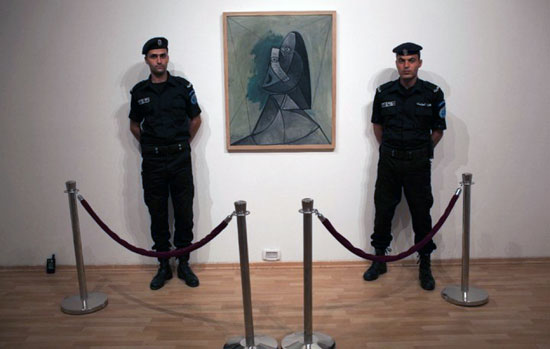Genet, Prisoner of Love, trans. Barbara Bray (New York: New York Review Books, 2003), 19.
When I asked Fatima AbdulKarim, who joined the Picasso in Palestine project after quitting her job at the PA Ministry of Foreign Relations, about Outset Contemporary Art Fund and its relationship to Israel (Outset, set up by Yana Peel and Candida Gertler—formerly a Goldman Sachs banker and a journalist, respectively—is a London-based arts charity with branch offices in Munich, Tel Aviv, and Mumbai), her answer was interesting for its diplomatic resourcefulness and careful negotiation of the issue:
Genet writes, “To anyone looking at their pictures on television or in the papers, the Palestinians seemed to girdle the earth so fast they were everywhere at once. But they saw themselves as swallowed up by all the worlds they travelled through.” (Prisoner of Love, 24.) He articulates a truth of which he may be only partially aware.
Ibid., 23.
Ariella Azoulay, The Civil Contract of Photography, trans. Reva Mazali and Ruvik Danieli, (Brooklyn: Zone Books, 2008), 12, 14.
Jean-Luc Godard and Anne-Marie Miéville, Ici et Ailleurs (Paris: Gaumont and Sonimage, 1976.)
Azoulay, ibid., 35-36.
Quoted in Walter Benjamin, “A Small History of Photography,” inOne Way Street and Other Writings (London: Verso, 1985), 255.
While watching a discussion on YouTube among Hourani, de Blaaij, and Slavoj Žižek, my attention was arrested by the following exchange that frames the stake over asserting normalcy or non-normalcy in an interesting manner:
Judith Butler, “Restaging the Universal,” in Contingency, Hegemony, Universality, Judith Butler, Ernesto Laclau, and Slavoj Žižek (London and New York: Verso Books, 2000), 40. The particularity of the universal haunts even its origins. Susan Buck-Morss asserts in “Hegel, Haiti, and Universal History” that in conceptualizing a master/slave dialectic, Hegel’s philosophical inquiry was inspired by his long advocacy of abolition and acute interest in the Haitian slave uprising against the French, which resulted in the first and only republic in the western hemisphere to be founded by former slaves, who based their political demands precisely on Enlightenment conceptions of universal rights denied them by the French.
Ibid., 32.
Ibid., 38.
The post can be found at →.
W.J.T. Mitchell, “What Do Pictures Really Want?” October 77 (Summer 1996): 76.
Butler et al., ibid., 39.
